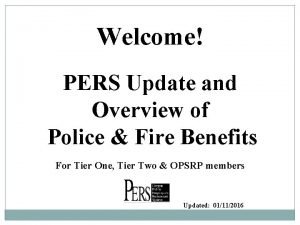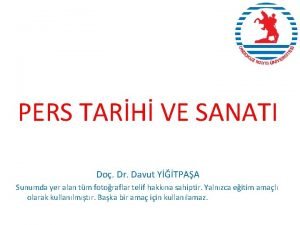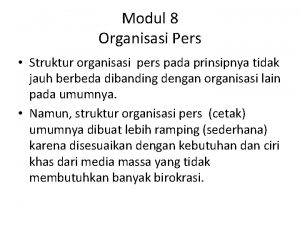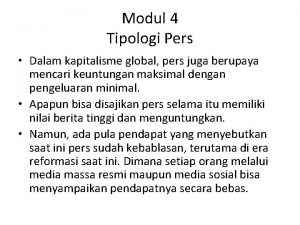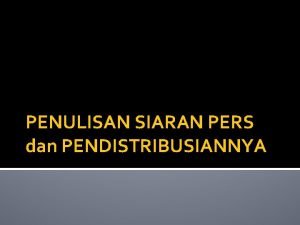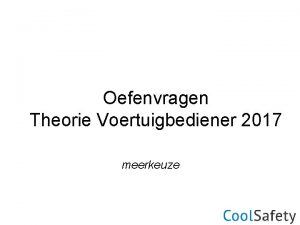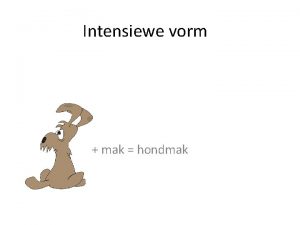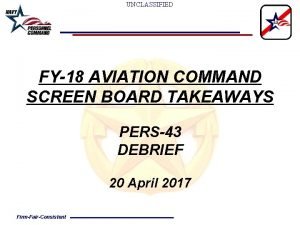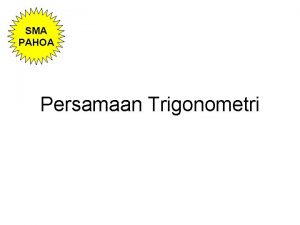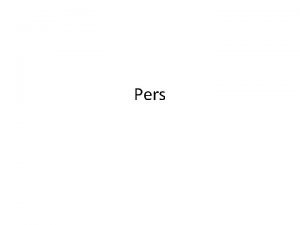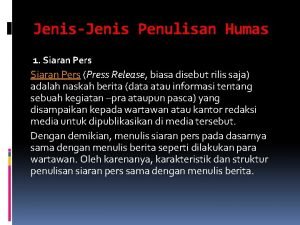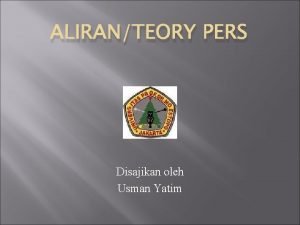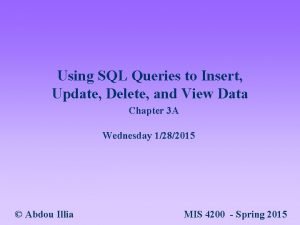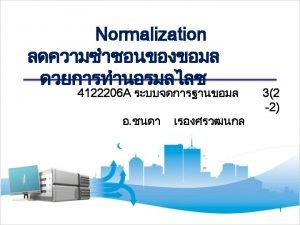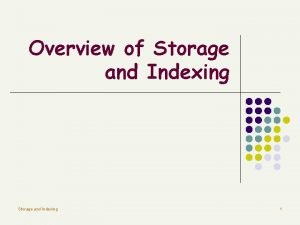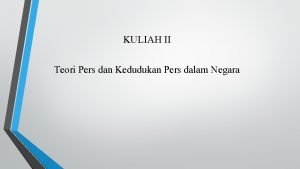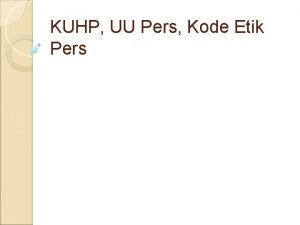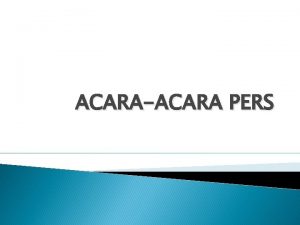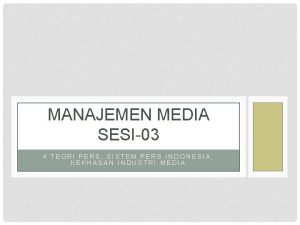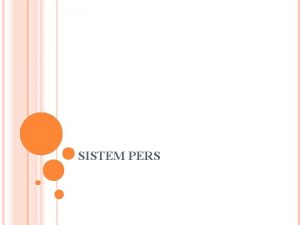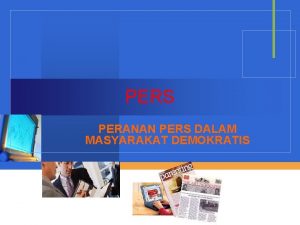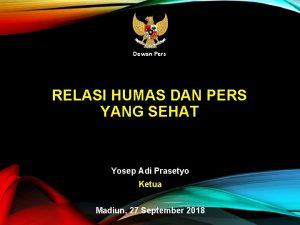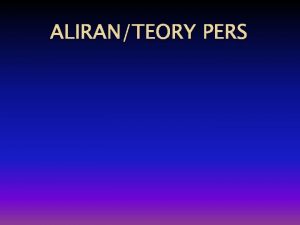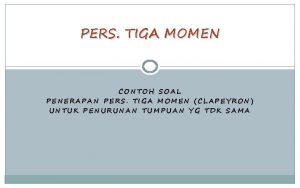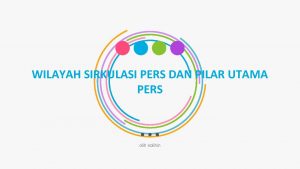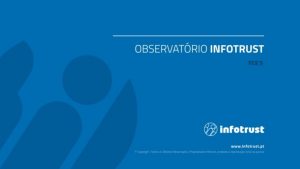Welcome PERS Update and Overview of Police Fire





































- Slides: 37

Welcome! PERS Update and Overview of Police & Fire Benefits For Tier One, Tier Two & OPSRP members Updated: 01/11/2016

Agenda § PERS Programs § Retirement Eligibility § Benefit Calculations § Benefit Estimates § Additional Benefits § Resources 2

Disclaimer Information in this presentation is subject to change as the result of administrative, legislative, or judicial decisions. 3

PERS Programs § Tier One: hired before January 1, 1996 § Tier Two: hired January 1, 1996 through August 28, 2003 § OPSRP: hired on or after August 29, 2003 § IAP: all active members since January 1, 2004 4

Retirement Eligibility Tier One/Tier Two § 30 years total PERS creditable service time (any age) OR § Normal retirement age § 58 – Tier One § 60 – Tier Two § 55 or 50 + 25 years total service–police & firefighter members (P & F) § Early retirement age § 55 § 50 – P & F 5

Retirement Eligibility OPSRP § Normal retirement age § 65 § 58 with 30 years of retirement credit § 60 or 53 + 25 years of retirement creditpolice & firefighter members (P & F) § Early retirement age § 55 § 50 – P & F Age 50, if the five prior years were as P & F member Age 55, if less than five years of P & F service time 6

Calculation Methods Tier One/Tier Two § Full Formula Service time & final average monthly salary & a factor of. 0167 (P & F. 0200) § Money Match Age factor & account balance x 2 § Formula + Annuity (8/21/81) Service time & final average monthly salary & a factor of. 01 (P & F. 0135) + Age factor & account balance 7

P & F Split Service (if Relevant) § Applies to formula calculations if a member has both P & F and General Service time § Benefit calculated for general service time, and added to benefit calculated for P & F time 8

Calculation OPSRP § General Service Final average monthly salary & years of retirement credit x 1. 5 § P&F Final average monthly salary & years of retirement credit x 1. 8 9

Benefit Estimates: Written estimate § Must be eligible to retire within two years § Provided for retirement dates that are within the next 24 months § Submit an Estimate Request Form § Tier One and Tier Two only § § Waiting time and forfeited time purchase information is provided (if eligible) Can request unit account information on the estimate request form, section G 10

Benefit Estimates: Online Member Services § Access and view activities related to your account § Produce unlimited estimates § Link directly to the PERS website to view handouts, FAQs, forms, and other information After retirement use to: § View benefit payments, view and request tax information § Print paystubs and benefit confirmation letters § Change address http: //Oregon. gov/PERS 11

Active Member Benefits § Disability benefit § Death benefit § Tier One and Tier Two only § Units § Surviving Spouse Benefit 12

Disability benefits § Disability eligibility and benefits are the same for both P & F and non-P & F members § Non-Duty disability: must have 10 years of service § Duty disability: no minimum service time required 13

Death Benefits Tier One/Tier Two § Money Match calculation to chosen beneficiary OPSRP § § § Paid if member vested at time of death Lifetime benefit paid to spouse Benefit shall be actuarial equivalent of 50 percent of pension member would have received 14

P & F Units – Tier One/Tier Two only § No COLA increases § Unit payment start date can be at or after PERS retirement date § Any amount in excess of $4000 is paid in a lump sum when unit payments begin 15

P & F Units – Tier One/Tier Two § Purchase (8 Units) Employee cost = $4, 000 § Employer match = $4, 000 § Benefits § $80 per month from member account and $80 per month from Employer. For a total monthly benefit of $160 per month for 60 months (8 Units) § Less if taken out in more than 60 months § Unit account must be depleted by age 65 § Employer payment capped at $80 per month § 16

Surviving Spouse Benefit - Tier One/Tier Two § 25% of Refund Annuity benefit OR § 25% of Option 1 benefit (Lump Sum options) § Beneficiary § Surviving spouse’s lifetime OR § Dependent children until age 18 (if no surviving spouse) 17

2006 Federal Pension Protection Act § Allows eligible retired Public Safety officers to exclude from their income up to $3, 000 of retirement benefits that are paid directly from their retirement plan to their insurance provider for Health and Long Term Care insurance premiums. § Members should discuss their eligibility for this deduction with their tax professional. § Information is also available on the IRS website at www. irs. gov 18

Member Resources § PERS website § http: //oregon. gov/PERS includes Online Member Services which uses data provided by PERS employers and an IAP disbursement forecaster to estimate IAP payments § PERS Member Services: customer-service. pers@state. or. us 888 -320 -7377 § IAP account: https: //iap. voyaplans. com § PERS Health Insurance: http: //pershealth. com 800 -768 -7377 or 503 -224 -7377 19

Member Resources § Attend additional PERS presentations § Tier One/Tier Two § Retirement Readiness ~ retiring in less than three years § Introduction to PERS Retirement ~ retiring in more than three years § OSPRP § All About OPSRP ~ OPSRP members in any stage of career Register through PERS website www. oregon. gov/PERS § Pre-Retirement Guide § Retirement Application Assistance Session (RAAS) § Within the 90 days prior to retirement 20

PERS Update A presentation to Oregon Firefighters Steven Patrick Rodeman Executive Director January 11, 2016 oregon. gov/pers

PERS: Historical Perspective Governor Earl Snell signed PERS into law on March 26, 1945 § Early 1940 s: Public employers could not compete with private industry’s higher wages and the promise of retirement benefits in a wartime economy § At that time, less than 8% of public employees in Oregon were covered by a retirement system compared to 46% of public employees in other states § PERS was created in 1945 to attract qualified people to public service and provide fair retirement benefits for their service to Oregonians 22 SL-1

Who is PERS? STATE 57, 654 Membership Tier One: 49, 687 Tier Two: 57, 945 OPSRP: 98, 612 (INCLUDES UNIVERSITIES ) RETIRED MEMBERS 132, 950 LOCAL GOV’Ts COUNTIES, 52, 696 (CITIES, COMMUNITY COLLEGES, ETC. WHO ELECTED TO JOIN SLGRP) SCHOOL DISTRICTS 80, 104 As of 12 -31 -14 23 INDEPENDENTS 15, 799

PERS Membership, Retirements, and Benefits § ~7, 300 retired in 2015; nearly 70, 000 members are eligible to retire § Average at retirement: 61 § Average years of service at retirement: 22 § Average annual benefit for all current retirees: $27, 722 § Average annual benefit for 2014 retirees: $28, 168 (44% average replacement rate of final salary) § Average annual benefit for 2014 retirees with 30 years service: $44, 964 (66% average replacement rate of final salary; majority with 30 years of service are Money Match) 24 SL 1

The PERS Funding Equation At the end of each calendar year, the PERS actuaries calculate the system’s funded status using the following basic equation: B=C+E BENEFITS = CONTRIBUTIONS + EARNINGS present value of earned benefits Set by: Oregon Legislature employer funds to pay pension benefits Set by: PERS Board future returns on invested funds Managed by: Oregon Investment Council Every two years, the PERS Board adjusts contributions so that, over time, those contributions will be sufficient to fund the benefits earned, if earnings follow assumptions. 25 SL 1

Solving the Equation. . . When setting employer contribution rates, the PERS Board has the following objectives: § Transparent process and inputs § Predictable and stable employer contribution rates § Protect funded status to secure future benefit payments § Equitable across generations of taxpayers funding the system § Actuarially sound – fully fund the system if assumptions are met § GASB compliant Some of the objectives can conflict, particularly in periods with significant volatility in investment return or projected benefit levels. Overall system funding policies should seek an appropriate balance between conflicting objectives. 26

Problem: the “B” and “C+E” Don’t Align Present Value of Future Normal Cost – Actives: $7. 5 OPSRP Active Members: $2. 8 Present Value of Future UAL Contributions: $18. 0 Tier Two – Active Members: $6. 4 Inactive Members: Tier One/Tier Two Member Accounts: $4. 9 Tier One/Tier Two Employer Reserves: Retired Members: $6. 9 $22. 8 $46. 4 Tier One/Tier Two Benefits in Force Reserve: $23. 8 Dollars shown in billions Obligations (“B”) 27 As of 12 -31 -14 Resources (“C+E”) (Excludes Side Accounts, Contingency Reserve, and Tier One Rate Guarantee Reserve) OPSRP Employer Pool: $2. 0 ASSETS $55. 5 ACCRUED LIABILITY $73. 5 TOTAL LIABILITY $81. 0 Tier One – Active Members: $13. 0 UNFUNDED ACTUARIAL LIABILITY $18. 0 Present Value of Future Normal Cost – Actives:

System Funded Status and UAL ($ in billions) Actuarial liability Assets (excluding side accounts) UAL (excluding side accounts) Funded status (excluding side accounts) 12/31/2013 $62. 6 $54. 1 $ 8. 5 86% 12/31/2014 $73. 5 $55. 5 $18. 0 76% Side account assets UAL (including side accounts) Funded status (including side accounts) $ 5. 9 $ 2. 6 96% $ 5. 9 $12. 1 84% Sources of 2014 UAL Increase Expected UAL increase during 2014 actual investment performance below assumption Moro adjustment to projected benefits Decrease in assumed return to 7. 50% Update to mortality assumption All other assumption changes and actual experience Total Milliman presentation; September 25, 2015 Board meeting 28 UAL Increase $0. 2 B $5. 1 B $1. 7 B $1. 8 B $0. 5 B $9. 5 B

Projected Benefit Payments Tier One/Tier Two expected benefit payments by status as of 12/31/2014 Milliman presentation; September 25, 2015 Board meeting 29

System-Wide Pension Rates Excludes Retiree Health Care, IAP Contributions, Side Accounts 12/31/2013 2015 - 2017 Final 12/31/2014 2017 - 2019 Advisory Payroll Tier 1/ Tier 2 OPSRP Weighted Average 1 Normal Cost 13. 18% 7. 79% 10. 94% 15. 41% 8. 63% 12. 30% Tier 1/Tier 2 UAL 6. 63% 13. 68% OPSRP UAL 0. 61% 1. 01% 20. 42% 15. 03% 18. 18% 30. 10% 23. 32% 26. 99% 9. 68% 8. 29% 8. 81% (6. 25%) 4. 15% 2. 76% 3. 28% Uncollared Rate Increase Collar Limitation (0. 72%) Collared Base Rate 1 (0. 72%) Weighting based on the pool’s payroll levels (Tier 1/Tier 2, OPSRP) as of the valuation date. Milliman presentation; September 25, 2015 Board meeting 30 (0. 72%)

2017 -19 Contribution Increase Estimates Projected 2015 -17 Payroll* (A) Projected 2015 -17 Contribution Projected 2017 -19 Payroll* (B) Projected 2017 -19 Contribution (B) - (A) Projected Contribution Increase State Agencies $5, 580 $575 $5, 980 $800 $225 School Districts $5, 950 $560 $6, 370 $850 $290 All Others $7, 350 $870 $7, 870 $1, 155 $285 Total $18, 880 $2, 005 $20, 220 $2, 805 $800 ($ millions) * Assumes payroll grows at 3. 50% annually based on 12/31/2014 active member census, reflecting proportional payroll composition (Tier 1/Tier 2 vs. OPSRP) as of 12/31/2014 § Projected 2017 -19 contributions are determined by applying collared net advisory rates calculated in the 12/31/2014 valuation § Projections do not reflect the effects of actual 2015 investment returns Milliman presentation; September 25, 2015 Board meeting 31

Collared System Average Base Contribution Rates “Base” rates are system average Tier One/Tier Two/OPSRP contribution rates excluding IAP contributions, the effect of side accounts & pension obligation bond debt service, and contributions to the retiree healthcare programs CONTRIBUTION (% OF PAYROLL) 70% 60% Rates for 2019 -2021 are based on the modeled returns for the three-year period ending 12/31/2017 50% 40% 30% 20% 10% 0% Biennium 5 th 10 th 25 th 50 th 75 th 90 th 95 th 2013 -2015 16. 4% 16. 4% 2015 -2017 17. 5% 17. 5% 2017 -2019 21. 4% 20. 9% 20. 8% 20. 7% 2019 -2021 30. 7% 30. 5% 29. 3% 25. 4% 24. 8% 19. 4% 16. 0% 2021 -2023 43. 6% 42. 4% 37. 2% 30. 9% 22. 9% 17. 5% 14. 2% 2023 -2025 49. 9% 46. 5% 40. 0% 31. 1% 21. 7% 13. 7% 10. 5% 2025 -2027 51. 9% 48. 4% 40. 9% 31. 1% 19. 9% 10. 6% 5. 6% 2027 -2029 53. 5% 49. 5% 41. 7% 30. 4% 17. 6% 6. 6% 0. 0% 2029 -2031 55. 2% 50. 7% 42. 0% 30. 1% 15. 5% 1. 4% 0. 0% 2031 -2033 56. 5% 51. 3% 42. 4% 29. 5% 13. 0% 0. 0% 2033 -2035 57. 2% 52. 0% 42. 6% 28. 5% 9. 9% 0. 0% Milliman presentation; November 20, 2015 Board meeting 32 SL 1

Steady Return Model Projections At assumed return, the rate eventually drifts downward due to new hire OPSRP members replacing retiring Tier One/Tier Two members If actual investment results are near assumption, employer contribution rate increases to begin to amortize unfunded liability are spread over three biennia The steady rate model illustrates impact of consistently achieving the assumed 7. 50% return and three alternative returns Milliman presentation; November 20, 2015 Board meeting 33 SL 1

Steady Return Model Projections Differences between the two sets of model results caused by reflecting Moro decision, assumption changes, and investment underperformance during 2015 § Current year: reflects Moro decision, 12/31/2014 valuation, and investment results through October 2015 § Prior year: pre-Moro, 12/31/2013 valuation, and investment results through October 2014 Milliman presentation; November 20, 2015 Board meeting 34 SL 1

Steady Return Model Projections Funded status reaches 100% in 2033 when actual investment returns equal 7. 50% At 7. 50% actual return, funded status declines in initial years, then stabilizes and ultimately improves as contribution rate increases take effect Shows projected funded status under steady return projections Milliman presentation; November 20, 2015 Board meeting 35 SL 1

Total PERS Benefit Payments by County in 2014 PERS Employer Profile by County in 2014 36 DRAFT

Total PERS Benefit Payments by County in 2014 § PERS benefits paid to Oregonians in 2014: $3. 3 billion § Total increase in Oregon economic output: $3. 9 billion in 2014 (compared to employer contributions of approximately $2 billion) § Oregon jobs supported: 35, 999 § Wages of Oregon jobs supported: $1. 1 billion § Estimated state income taxes paid by PERS retirees in Oregon : $171. 7 million 37
 Opsrp retirement calculator
Opsrp retirement calculator Which is an alternative of log based recovery
Which is an alternative of log based recovery Fire and police selection inc
Fire and police selection inc Reichstag fire who was the fire starter
Reichstag fire who was the fire starter Alarm
Alarm Uttar pradesh fire prevention & fire safety rules, 2005
Uttar pradesh fire prevention & fire safety rules, 2005 Ire fire fire rwi
Ire fire fire rwi Fire definition
Fire definition Wise men three clever are we
Wise men three clever are we Unsur penting dalam siaran pers menurut frank jefkins
Unsur penting dalam siaran pers menurut frank jefkins Pers sanatı
Pers sanatı Pers imparatorluğu sınırları
Pers imparatorluğu sınırları Struktur pers
Struktur pers Tipologi pers
Tipologi pers Materi pkn kelas 12 peranan pers di indonesia
Materi pkn kelas 12 peranan pers di indonesia Contoh penulisan siaran pers
Contoh penulisan siaran pers Waarom centrifugaalpomp starten met gesloten pers
Waarom centrifugaalpomp starten met gesloten pers Intensiewe vorm mooi
Intensiewe vorm mooi Aviation screen boards
Aviation screen boards Globale puntenenveloppe secundair onderwijs
Globale puntenenveloppe secundair onderwijs Rumus persamaan trigonometri
Rumus persamaan trigonometri Secara harfiah kata pers berasal dari bahasa kecuali
Secara harfiah kata pers berasal dari bahasa kecuali Karakteristik siaran pers
Karakteristik siaran pers Pers aswani
Pers aswani Janez perš
Janez perš Teori pers otoriter
Teori pers otoriter Food product knowledge training
Food product knowledge training Sql queries for insert update and delete
Sql queries for insert update and delete Data redundancy and update anomalies
Data redundancy and update anomalies Virusmax
Virusmax Data quality and data cleaning an overview
Data quality and data cleaning an overview Elements and their properties chapter 17
Elements and their properties chapter 17 Chicago time
Chicago time What is bioinformatics an introduction and overview
What is bioinformatics an introduction and overview An overview of data warehousing and olap technology
An overview of data warehousing and olap technology Data quality and data cleaning an overview
Data quality and data cleaning an overview Data quality and data cleaning an overview
Data quality and data cleaning an overview Overview of storage and indexing
Overview of storage and indexing
